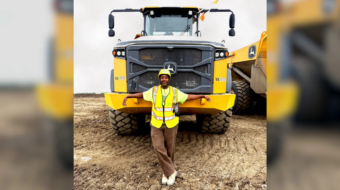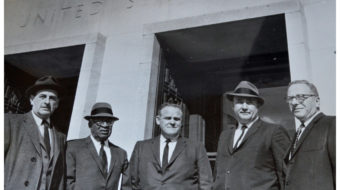
Finally, it’s a new morning for workers in America. For at least a brief time, while the Biden administration is alive, even if unwell, and the Supreme Court has not yet brought the darkness and ended our parade, opportunity is bursting out in the most surprising places. We have a “movement moment” for workers seeking their rights on the job and demanding a union. Amazingly, we also have a National Labor Relations Board (NLRB) that has reinvigorated itself with a stiff backbone and finally accepted its mission as protecting workers and their rights to organize.
We all are familiar with the perfect storm that has put the wind to workers’ backs now and is providing leverage to couple with opportunity. The pandemic unveiled workers’ reality and reaffirmed their centrality in all phases of the economy. The labor shortages that have forced some bosses to reckon with the fact that workers are not interchangeable widgets are also creating shortfalls that workers are exploiting. Inflation and shortages have forced wages upward and emboldened workers to take action for more.
The evidence of this movement moment seems everywhere now. Amazon workers have not only organized in Alabama and New York. Groups like Amazonians United have agitated in another dozen locations on issues inside warehouses, distribution, and delivery centers. Starbucks workers have filed for election in hundreds of stores and are winning most of the elections held to date. Apple retail workers are organizing, as are tech workers at game companies, online news platforms, and elsewhere. Google workers have kicked up their heels.
It’s not just the young, the digital, the hip, and the techies. It’s also workers at Dollar General, the ubiquitous store in lower income, minority, and rural communities across the country. Mary Gundel, a Dollar General worker, posted a TikTok voicing her issues with the company. She recently told me that she’s surprised to find herself leading a “movement” of DG workers, though she felt clueless about how to mobilize the “concerted activity” necessary for union organizing, but she also made clear that her emerging understanding and leadership come in part from the “new” NLRB. For once, the Board is actually protecting workers’ rights instead of cowering before the endless manipulations of management. Part of the credit goes to the new general counsel, Jennifer Abruzzo, who recognizes that the NLRB should ride this new wave of worker activism, not serve as the dam holding it back.
Once rare, temporary injunctions against companies have been falling like rain for a change. Amazon is still stunned and whining about the NLRB filing for an injunction in the case of a discharged Amazon worker before the Staten Island election with the Amazon Labor Union, making it the heart of their election objections. Earlier, the NLRB had consolidated six cases into a national settlement with Amazon, forcing the company to make comprehensive worker notifications and enabling the NLRB to file for injunctions without the delays of a hearing before an administrative law judge. They filed another one in response to a firing at a Starbucks in Tucson and issued complaints on seven fired workers in Memphis. This is a sea change.
For labor organizers dealing with rampant unfair labor practices, Gissel bargaining orders used to be the holy grail. A Gissel order forces a company to bargain with the union without an election, based on a Board finding that the company had soiled the laboratory conditions for a fair election by the workers irreparably. The new NLRB is now looking to best that standard by going back to the Joy Silk decision, which the Gissel ruling supplanted, arguing that it should be an unfair labor practice if a union isn’t recognized by the employer once a majority have signed authorizations and demanded such recognition.
Mandatory captive audience meetings have been a major employer weapon deployed against workers and their unions in organizing drives and election campaigns. The NLRB’s current advisory is that such meetings, if mandatory, are unfair labor practices. That won’t stop all of them, but it will make management lawyers and consultants hesitate to use them too strongly for fear of an election overturn.
All of this is good. How can we make the most of this movement moment? I’ve learned a key lesson from more than 50 years as a community organizer with ACORN and more than 40 years organizing unions with the United Labor Unions, SEIU, and other labor organizations: In times of movement, put the pedal to the metal. Don’t go slow, go hard! The moment never lasts as long as you want or need, so you have to do everything you can while the opportunity exists. I think we have every reason to believe that it’s time to push.
Institutional labor may feel that they have to continue to move towards members and contracts, and we should support those efforts. But in this moment, we should also support workers anywhere and everywhere who are willing to engage in collective action to improve their jobs, union or no. A couple of elections at Amazon or Starbucks puts some pressure on their companies, but these are huge operations with hundreds or even thousands of locations. Workers are willing and able to take concerted action over their issues right now, and if enough take action, they could increase the pressure for change exponentially. Much as sit-down strikes spread like wildfire in their day, at-work collective worker actions could generate mass organizing. We need to help overwhelm companies with worker action on as many fronts as possible. We need to keep pushing the NLRB to support workers.
One way to contribute is by sharing knowledge and resources. We’re taking a small step in this direction by creating an online worker organizing support center using an application that is attuned to individual groups of workers organizing, ActionBuilder. We also have a team of experienced organizers and lawyers willing to handle questions, mentor leaders, and give workers advice. And we’d love to use our database of 150 million registered voters to help build support for local organizing efforts. This is a huge opportunity to create community-labor partnerships where people work and where they live.
My point is simple. This movement moment probably won’t last. We all need to do what we can now to stand with workers for a change.
This article originally appeared at Working-Class Perspectives. It appears here with permission.










